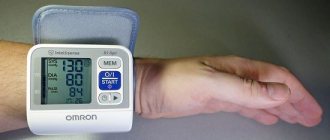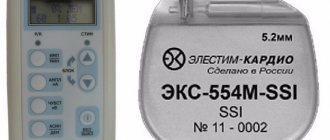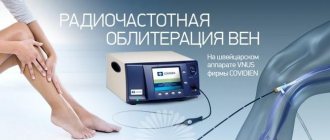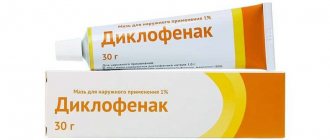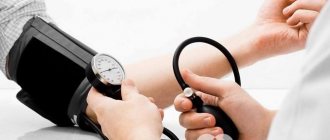Features of wrist tonometers
A wrist tonometer is a portable blood pressure monitoring device. Tonometry is performed by clamping the radial artery on the inner surface of the arm up to 2 cm below the palm.
The first devices on the wrist appeared in the 90s of the last century. Today they can successfully compete with electronic shoulder blood pressure monitors.
Wrist devices are compact in size and, as a rule, include a control unit with a monitor attached to the cuff. Most of them run on standard batteries. But some devices also have a power supply for a stationary electrical network.
The operating principle of the device is similar to electronic shoulder models:
- after pressing the “start” button, the internal compressor pumps air into the cuff to values exceeding systolic blood pressure by 10-20 mm Hg. Art.
- then, automatic bleeding of air begins.
- Upper and lower blood pressure sounds, as well as heart rate, are read by an electronic microprocessor board.
- the results are displayed for viewing.
Their functions include:
- blood pressure measurement;
- pulse rate measurement;
- memory with a certain number of dimensions.
Depending on the price category of the tonometer, additional options may be included:
- voice notification;
- date, clock, alarm;
- accuracy settings.
Because tonometry is performed on the radial artery, the wrist device is not suitable for everyone. In people over 50 years of age, the results may be incorrect, since blood vessels lose their former elasticity with age, tones are not heard clearly, which leads to underestimation or overestimation of numbers.
In addition, if there is an arrhythmia, work is difficult or impossible, about which a written message is sent.
Wrist electronic tonometer
The electronic wrist tonometer differs from the usual one in that it measures the pressure in the human wrist. This device is much more compact than the usual shoulder-mounted ones, takes up little space and is suitable for use outside the home. It is very convenient to measure blood pressure with this tonometer anywhere: at work, while traveling, or just while walking.
Hypertensive patients, pregnant women or people with diabetes (and other people for whom it is important to constantly know their blood pressure) can take a portable tonometer with them in a special bag-case. It won't take up much space, but will always allow you to know your performance. In addition to pressure, the wristband will help you find out the value of your pulse after playing sports or experiencing stress.
Almost all models, in addition to the wire for connecting to the network, come with a set of batteries. Thanks to this, the device can be taken with you on trips where there is no way to charge it.
Pressure control rules
To obtain the most accurate blood pressure measurement results, you need to use an electronic tonometer on your wrist correctly, following the following algorithm:
- Get ready. Do not smoke, drink alcohol, or eat hot or spicy foods half an hour before the procedure. An hour before, stop physical activity. Go to the toilet if you have the urge.
- Sit comfortably, relax without crossing your legs and arms.
- Place the cuff of the device on your bare wrist without pinching it. The monitor should be on top of the inside of your left arm.
- Bring your hand with the tonometer to the right half of your chest in the projection of the heart, press the “start” button. Placing the hand above or below the heart will lead to distortion of the results - underestimation or overestimation, respectively.
- Refrain from gesturing and talking while operating the device.
The measurement data will be saved by memory automatically. If necessary, the measurement log is available for display.
By adhering to these simple rules, you can get the correct numbers for upper, lower pressure and pulse. Failure to comply with them will lead to distorted results.
We measure the pressure on the wrist
Elena, 09/19/2016
We have already written that as a result of one of the studies, doctors came to the conclusion that most negative reviews about wrist tonometers are due to the fact that people simply do not know how to measure blood pressure with them.
At the same time, the accuracy of the gadgets and the adequacy of the indications, double-checked in a clinical setting, are beyond doubt. Let's figure out how to correctly measure the pressure on your wrist.
Who is it convenient for?
It is usually said that wrist blood pressure monitors are absolutely not suitable for the elderly. There are a number of reasons for this.
As a rule, it is recommended to measure from the wrist up to 40-45 years old, and from the shoulder - for older people. The fact is that the vessels on the wrist lose elasticity over time, so there is a high risk of a large error. The second reason is atherosclerosis of the arteries, in which the readings may also be inaccurate.
And, finally, the accompanying deviations in some cases, for example, tremor, can disrupt and skew the measurement process in one direction or the other.
How to measure
Today there are a number of efforts to make the blood pressure measurement process less “traditional.” Attempts to create a “tonometer-clock” are being made systematically. Here are just a few gadgets that come close to this: the Taiwanese company Rooti introduced W/me2 with pressure calculation based on the speed of propagation of the pulse wave.
Healbe Gobe, a project with Russian roots, among other features, promised to measure blood pressure. One of the Samsung divisions is developing the Simband gadget. Recently it became known that the Chinese smartphone manufacturer has launched its H-One smartwatch. The SoWatch team is also working on a similar project.
Omron seems to have come closest to this format. At the last CES2018 exhibition, a working prototype of a blood pressure monitor was already shown!
Despite all efforts, the only reliable device for measuring pressure on the wrist is a tonometer! They are sold in pharmacies, doctors trust them, and their accuracy has been confirmed by hundreds of clinical trials.
Digital blood pressure monitor on the wrist
Technology makes mistakes, but humans make mistakes even more often, so now the trend is towards recommendations in favor of digital tonometers, which would eliminate the human factor in measurements: they inflate themselves, deflate themselves, do everything themselves and show the data on the display.
Having said that, a good wrist pressure measuring device should now have several more advantages:
- Big numbers
- Arrhythmia detection function!
- Visual charge indicator to eliminate battery errors in time
- World Health Organization color chart
The latter is needed so that the user at home can interpret the results, and in the case of high values, when the arrow points to orange or red, can promptly consult a doctor for clarification.
Memory
Everything is relative. It’s not enough to take a measurement, it’s important to save it and compare it with other measurements, and not numbers to numbers, but also behavior patterns that day, nutrition, walking... Simply put, “remember everything” that could directly or indirectly influence the readings.
Built-in memory for dozens of measurements is usually provided in digital models.
Several models to choose from
Among wrist tonometers with such parameters, there are several popular medical models:
Omron R1. A clear display and compact size, easy measurement of both pressure and pulse, as well as patented Intellisense technology - painless injection.
B.Well Wa-88. This tonometer has a built-in memory for 30 measurements and guarantees accuracy while observing all rules +/- 3 mmHg. Art. Due to the flatter design of the main digital part, it looks lighter and more compact!
AND UB-201. Wrist tonometer from a famous Japanese manufacturer of medical equipment. The main concept implemented in this gadget is simplicity. Access to the measurement is carried out with one button, which allows you to take measurements quickly and clearly.
How to measure
In order for the readings to be accurate, a number of conditions must be met. It is not difficult to physically prepare for the measurement: it is enough to be calm for 20-30 minutes before the measurement.
We are not talking about deliberately turning yourself into an “amoeba”: it is simply enough to do ordinary things as usual, without subjecting yourself to deliberate stress.
Some recommend not drinking alcohol and tobacco, of course, unless there is a need to check their effect on pressure surges.
Pressure can be measured with a wrist tonometer both sitting and standing. The sensor with the display should be turned “facing you”, and the cuff should be placed at a distance of about 1 cm from the palm.
Next, you need to lean your hand with the tonometer against your chest, at the level of your heart, and with your free hand, grab and support the elbow of the arm with the device.
In this case, the discrepancies with the shoulder structures, which are considered “more standard”, will not exceed acceptable standards, usually 5 - 6 - 7 units.
Medisana tags, pressure, tonometer
Advantages and disadvantages
Wrist blood pressure meters are devices that have a number of advantages that make them quite popular. Their undeniable advantages include:
- Compact and mobile. The device's small size and battery operation allows you to have it with you almost always.
- No need for additional equipment (only a chair is needed).
- Measurement speed. A small cuff significantly reduces the procedure time.
- Ability to record results and compare them.
But along with their advantages, wrist tonometers have a number of disadvantages, which is why many people prefer shoulder models. These include:
- The readings are correct only for people under 50 years of age.
- The cuff size is 21 cm, which makes it difficult for obese people to use the device.
- Refusal to work in case of hand tremors, joint disease, scars or insufficient battery charge.
Wrist tonometers are the ideal choice for young people, athletes who value their time. The purchase of such devices by older people often turns out to be a waste of money.
Measurement methods and techniques
Next, we consider the rules for recording indicators using various types of tonometers and in different projections of large arteries.
Standard mechanical measurement
We are talking about the Korotkov method. The arm is freed from clothing so that the sleeve does not squeeze the shoulder above the level of the cuff. The cuff of the device is applied to the projection of the brachial artery (several centimeters above the elbow). Before starting the procedure, you need to check that one finger fits between the cuff and the patient’s hand. Use your finger to find the pulsation point of the artery and place a phonendoscope in this place.
Next, the air blower valve is closed, the air is pumped until the noise and knocking in the phonendoscope disappear. Next, another 30 mmHg is added. Art., after which the air gradually descends, at the same time the appearance of the first knock is heard. The first knock is the first Korotkoff sound, which corresponds to the systolic (upper) pressure figure. Next, specialists listen to the second, third and fourth Korotkoff sounds. Only medical staff can understand the differences between them. The fifth tone is the moment during which the sound of the tones disappears. The number at which the fifth tone is recorded corresponds to the diastolic (lower) indicator.
Important! Some patients do not have a fifth Korotkoff sound. In this case, the fourth tone corresponds to diastolic blood pressure.
How to use a semi-automatic
The algorithm of actions is as follows:
- In addition to the general preparation of the patient, which is described above, you need to check the connection of the cuff and bulb tubes to the corresponding connectors on the device.
- Attach the cuff in the same way as when measuring with a mechanical device.
- Press the button responsible for removing excess air from the cuff.
- Inflate air only after the heartbeat icon appears on the device screen.
- An audible signal will alert the patient when to stop pumping. Then the air will descend on its own at the required speed. Blood pressure numbers will appear on the tonometer screen.
Example of a semi-automatic tonometer
automatic devices are good because they can record the presence of arrhythmia in a patient. If the heartbeat rhythm is abnormal, a corresponding icon appears on the monitor.
Electrical appliance
After the cuff is fixed slightly above the elbow bend, you need to select a memory block on which the result will be recorded. Next, all the necessary symbols will be displayed on the device’s display, followed by “00”. The next stage is automatic air injection, during which the heart rate is measured. After reaching the required peak, the air gradually descends. As a result, the following indicators are displayed on the device display:
- HELL;
- pulse;
- arrhythmia (if present);
- pressure level according to the World Health Organization scale.
Optimal pressure numbers are indicated in light green, normal – green, borderline – orange. The appearance of red flowers indicates hypertension: the higher the indicators, the darker the shade.
On the hip
How is pressure measured in the femoral artery? Experts recommend using mechanical devices. In this case, the cuff of the device is fixed at the level of the middle third of the thigh, and the phonendoscope is applied to the site of pulsation of the popliteal artery (below the knee). The diagnostic algorithm is fully consistent with standard measurements in the shoulder area. If blood pressure was measured in the lower extremities, 10–30 mmHg should be subtracted from the results obtained in the upper extremities. Art., and the lower indicator remains unchanged.
On the wrist
The wrist tonometer is placed at the level of the wrist joint with the display facing you. There should be a distance of 1 cm to the palm. When recording the results in a sitting position, the hand should be positioned so that the tonometer is at the level of the middle of the sternum. Wrist tonometers are automatic models, the instructions for use of which are described above. The permissible error in blood pressure results is 3 mm Hg. Art., heart rate – 5%.
How to choose an electronic blood pressure monitor on your wrist
Choosing the right pressure monitoring device is not difficult if you know the criteria for a successful purchase.
What to pay attention to:
- Functionality. If you need to measure your blood pressure frequently, choose a device that has a reminder function and a large memory log.
- Cuff length. The standard cuff of portable devices has a length of up to 22 cm, this must be taken into account by people who are overweight or have diseases of the arm joints.
- Allowable error. This information is indicated in the device's passport data. If absolute accuracy of values is important (for example, for hypertension), it is worth looking for a device that has the smallest error.
- Life time. High-quality models cannot have a warranty period of less than 5 years.
- Price. It depends on the set of functions of the model, as well as on the “name” of the manufacturer. Each company's line of devices includes inexpensive budget options. They are chosen by people who do not want to pay for functions they do not need.
A device purchased for the purpose of monitoring blood pressure outside the home (travel, business trip) must have powerful batteries, as well as a charger.
Patient preparation
First of all, you need to be sure that the device used to measure pressure is working properly. If we are talking about a mechanical device, the cuff must be completely deflated and the arrow must be at the zero mark. Otherwise, you should contact a specialist to calibrate the device. It is also important to ensure that the cuff used is fully suitable for the person being examined. The diagnostic results will depend on this.
An hour before measuring blood pressure, you need to give up cigarettes, coffee and other drinks containing caffeine, and alcohol. And physical activity and the use of medications that affect blood pressure levels and heart rate are also not recommended (with the exception of vital conditions, in which the use of such medications is discussed with the attending physician). You can measure blood pressure in a standing, sitting, or lying position. Before the procedure, it is advisable to spend 7-10 minutes in a calm environment, catch your breath, and empty your bladder. The numbers should be measured on both arms (or legs) at intervals of several minutes.
Top 3 Best Inexpensive Wrist Models
The list of reliable budget blood pressure monitors below includes models in the price category up to 3 thousand rubles. They are preferred by buyers and are also completely trusted by doctors.
B.Well WA-88
Stylish silver device with a four-line large screen. The memory is designed for 30 measurements, which is correctly displayed for viewing by the device’s intelligence - Fuzzy Logic. In addition to the main options pressure and pulse, there are additional ones: calendar, clock, battery charge level.
The model comes with a convenient carrying case. The average battery life is about 2 months.
AND UB-202
An ultra-sensitive device, one of the few that works correctly for people of different ages, including the elderly. It has a limited number of buttons (start, memory), as well as preset functionality. The screen size is small, but the numbers are clearly displayed. Options: pulse, pressure, arrhythmia indicator, WHO color scale for comparing results.
Buyers note its high reliability, reliability, and convenience.
Model overview
Currently, a huge number of medical companies are producing wrist tonometers, trying to make them as compact and easy to use as possible.
The permanent leaders in this industry are world-famous brands, such as:
- Omron (Omron);
- A&D (A&D);
- Nissei (Nissei);
- Microlife (Microlife).
There are also domestic producers. But they are, as a rule, inferior to foreign analogues.
The models differ in their electronic filling. All of them measure blood pressure, but some of them, for example, can remember up to 120 of the latest results for comparison. Some show the presence of arrhythmia. Others have brighter and larger displays, which is important for people with poor vision. Also, all options have different prices. On average, the price range of wrist blood pressure meters is 1200 - 2500 rubles.
Omron R2 tonometer is one of the most common models in pharmacies. It is compact and lightweight, and can remember the last 30 measurements for comparison. Automatically inflates the air in the cuff to the required level, eliminating physical pain from squeezing the wrist. Shows the presence of arrhythmia and correlates the latest results with the recognized norm. The cost of this device varies from two to three thousand rubles. You can buy it not only at the pharmacy - the device can be purchased at an online store with significant savings. In the second case, choose your store carefully.
Another popular model is the AND UB-202 tonometer. This device is characterized by a large display, stores 90 measurements and has a scale that evaluates pressure as high, low or normal. It also automatically inflates the cuff and is started with the press of just one button. In terms of price, this model is budget - its cost rarely exceeds 2,000 rubles.
tonometer ARMED YE-8100B can also be compared . It has a large memory resource and is capable of storing the latest 120 results. Has a multi-measurement mode to identify the average value. A compact and lightweight tonometer, the price rarely exceeds 1,400 rubles.
Choosing the right model is not difficult at all. To do this, you should carefully study all offers, compare prices and functionality. All wrist tonometers are certified, so cost does not play a special role in this case.
Features of electronic devices for measuring blood pressure
In order to measure pressure as accurately as possible with an electronic tonometer, you need to know what types of devices exist, since the algorithms for working with them are somewhat different.
Wrist devices, which record blood pressure on the thinner radial artery, are not recommended for blood pressure monitoring in people over 45 years of age or in patients with vascular disease.
Electronic blood pressure monitors come in two types: semi-automatic and fully automatic. In the first case, the device is equipped with a special rubber supercharger (bulb). The pressure figures are determined with the partial participation of the user himself: the cuff of the device is filled with air manually. Fully automatic devices operate without the participation of the patient; such devices do not have a rubber blower. To take a measurement, simply put on the cuff and press the button that activates the device.
Automated blood pressure monitors are available in two modifications:
- with a cuff that fits over the shoulder;
- in the form of a monoblock, which is fixed on the wrist like a watch.
Electronic devices operate according to the oscillometric principle. At the same time, highly sensitive sensors located in the air cylinder of the cuff read the vibrations of the air in it during the pulsation of the vessels - that is, not the shocks of blood in the arteries, but the shocks of air in the cuff.
For this reason, wrist devices, which record blood pressure at the thinner radial artery, are not recommended for blood pressure monitoring in people over 45 years of age or in patients with vascular disease. The measurement result in this case will have a high error.
Electronic tonometers are most convenient for measuring blood pressure yourself (without outside help), which is especially important for lonely, elderly patients, people with impaired vision and hearing, who find it difficult to use a manual device, as well as for patients who require systematic blood pressure monitoring.
Experts advise initially taking measurements on both limbs and then using the arm on which the readings were higher to determine blood pressure.
Which hand is the correct one to measure blood pressure on?
Blood pressure is measured in the upper forearm. You can use any hand, but keep in mind that the readings will be slightly different.
It is believed that right-handers have higher blood pressure on the left hand, and left-handers have higher pressure on the right, so it is recommended that right-handers take blood pressure readings from the left hand, and left-handers from the right.
In order to select one arm on which blood pressure readings will be taken continuously in the future, it is necessary to take measurements on both limbs 10 times with an interval of 5 minutes (to restore blood circulation). The difference in the values obtained from measurements on different hands is explained by the anatomical feature of the structure of the cardiovascular system of each individual person.
Mechanical tonometer
Measuring pressure with a mechanical device is the most difficult. It is important to approach the process very carefully and monitor the readings on the device.
How to use a mechanical tonometer:
- You need to relax before the procedure. If you come into the house from the cold, you need to warm up.
- It is necessary to take a sitting position, relax your legs and not cross them. Place your hands on a flat surface at heart level and keep motionless.
- A cuff is placed on the arm, the lower edge of which should be just above the elbow. The tonometer dial should be in front of your eyes to monitor the readings.
- Using a hand pump, inflate the cuff with air. The stethoscope is placed on the bend of the elbow, and the heartbeat should be clearly audible.
- The air begins to be gradually released until a tone appears, this is the upper (systolic) pressure. After the tones disappear, the reached mark on the dial will indicate the lower (diastolic) pressure.
- After a couple of minutes, the procedure is repeated, the average indicator most accurately indicates blood pressure. In case of possible heart rhythm disturbances, it is better to entrust the procedure to a healthcare professional.
On which hand should I measure and in what position?
Blood pressure shows how hard the blood presses against the walls of the arteries. To determine indicators, there are standardized boundaries that indicate the state of human health. They are reduced to two digits of the upper and lower values. They indicate the level of pressure when the heart valve closes, the heart relaxes, and the pulse at the wrist.
For this, a special device is used - a tonometer. Not everyone knows how to use a tonometer correctly. Let's look at the step-by-step instructions below.
As a rule, blood pressure is measured in the upper part of the forearm of the right or left hand, but it is worth clarifying that the indicators may vary. To determine the hand that is best to use, the pressure is measured on both limbs with a break of several minutes. Each reading is entered into the table, and after 10-12 measurements, all minimum values are eliminated. The hand on which higher values were established reflects the correct results.
Posture is also important. If a person is not a bedridden patient, then it is preferable to measure blood pressure while sitting. In this case, the legs should be relaxed, not crossed, the body should be leaned on the back. To get accurate results, you need to relax and sit quietly in this position before the procedure. The cuff of the device should be located at heart level.
Review of popular models and brief characteristics
Sphygmomanometers are available from various manufacturers. Articles are available in specialized medical stores, pharmacies or online stores. To choose the best sphygmomanometer, it is important to consider not the manufacturer, but the functionality and accuracy. Devices may come from brands such as Medisana or Panasonic, or be marketed by more obscure manufacturers.
Beurer
The Beurer blood pressure monitor comes from a manufacturer that has been on the market for almost 100 years. Production began with heating pads. Today, in addition to the Beurer blood pressure monitor, personal scales or seat massage pads are also produced.
High-quality devices such as the Beurer BM 58 provide fully automatic blood pressure and pulse measurement. The device, according to research by German scientists, has a low measurement error.
Boso
Boso is a company whose roots are in Vienna at the end of the 19th century. The first Boso sphygmomanometer was released around 1900 and was then considered a revolutionary innovation. Today, the Boso sphygmomanometer is virtually indispensable in medical practice, and home use models such as the Boso Medicus family are well established in testing blood pressure with medical accuracy.
Boso wrist tonometer
Sanitas
Sanitas is a brand that has been promoting devices since 2000. In addition to the sphygmomanometer, Sanitas also sells thermometers or heating pads. Powerful models such as the Sanitas SBM 21 have a wide range of functions and detect cardiac arrhythmias. A slight measurement error is the main drawback of this model.
Omron
Omron blood pressure monitor is a good choice for private health monitoring. Non-profit consumer organization Warentest recently announced the Omron RS2 as the comparative winner for the best blood pressure monitor of 2020. Therefore, this Omron blood pressure monitor is one of the declared favorites among wrist blood pressure monitors.
Panasonic
The Japanese company Panasonic is a leader in the production of technical equipment. The Panasonic EW-BW10 blood pressure monitor can be purchased at pharmacies and medical supply stores.
The Panasonic Sphygmomanometer has clinically proven measurement accuracy. Wrist tonometer studies were conducted in 3 studies, two of which were double-blind.
Criterias of choice
Based on the advantages and disadvantages, the device can be selected according to certain criteria. A simple brachial sphygmomanometer is relatively inexpensive. Cheap is not synonymous with poor quality, because even these simple devices provide fairly accurate results.
The assessment of values depends on the user himself. Anyone keeping a book and noticing abnormalities should consult a physician. Also, if in doubt, it is recommended to exclude possible fluctuations using a 24-hour blood pressure monitor.
Cheap blood pressure monitors with Bluetooth are, of course, devices without additional functions. However, the values can be managed and monitored via an app on Android or iPhone.
Functionality
A patient who suffers from fluctuations in blood pressure and expects particularly accurate results will likely consider price as a secondary factor and focus on accuracy.
A handheld sphygmomanometer can measure blood pressure and heart rate as reliably as a Bluetooth wrist sphygmomanometer. When purchasing a blood pressure monitor, personal preferences play an important role. The best blood pressure monitors are models from the brands Aponorm, Braun, Hartmann, Wepa, Uebe or Visomat.
Memory
Anyone who would like to monitor and evaluate certain values will use a blood pressure monitor with memory function. Test reports are almost exclusively for memory models.
Storage capacity depends on the number of people from whom data is to be collected. For a family of several people who regularly want to monitor their blood pressure, devices with memory function are available for 4 to 6 people.
Price
In some cases, the health insurance company will pay for the purchase of a sphygmomanometer. A prescription for the device is given to individuals suffering from hypertension. People with hypertension should have their blood pressure checked regularly for medical reasons, as possible damage to vital organs or a disease that is difficult to treat with medications cannot be ruled out.
High blood pressure during pregnancy or the need for health monitoring after an organ transplant is also covered by the general insurance company. All other customers must go to the store or purchase the necessary goods online.
